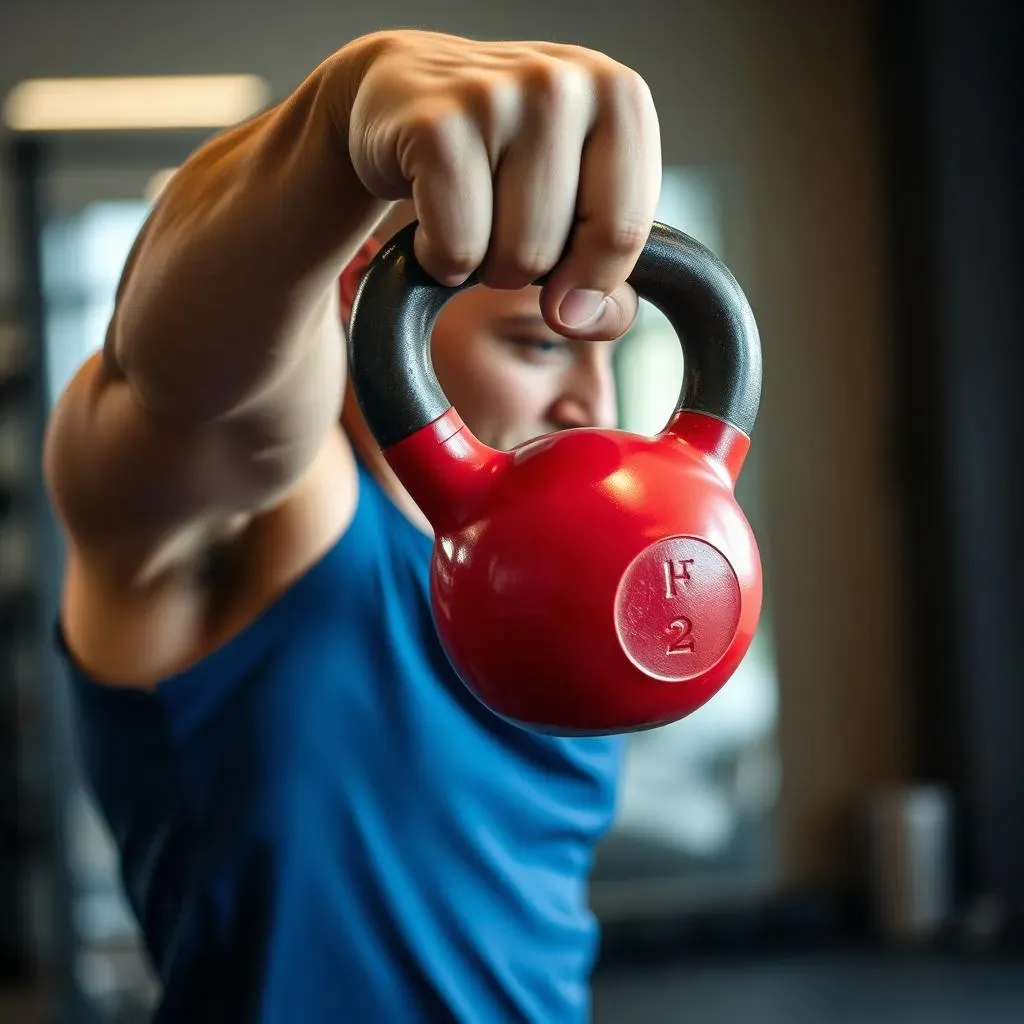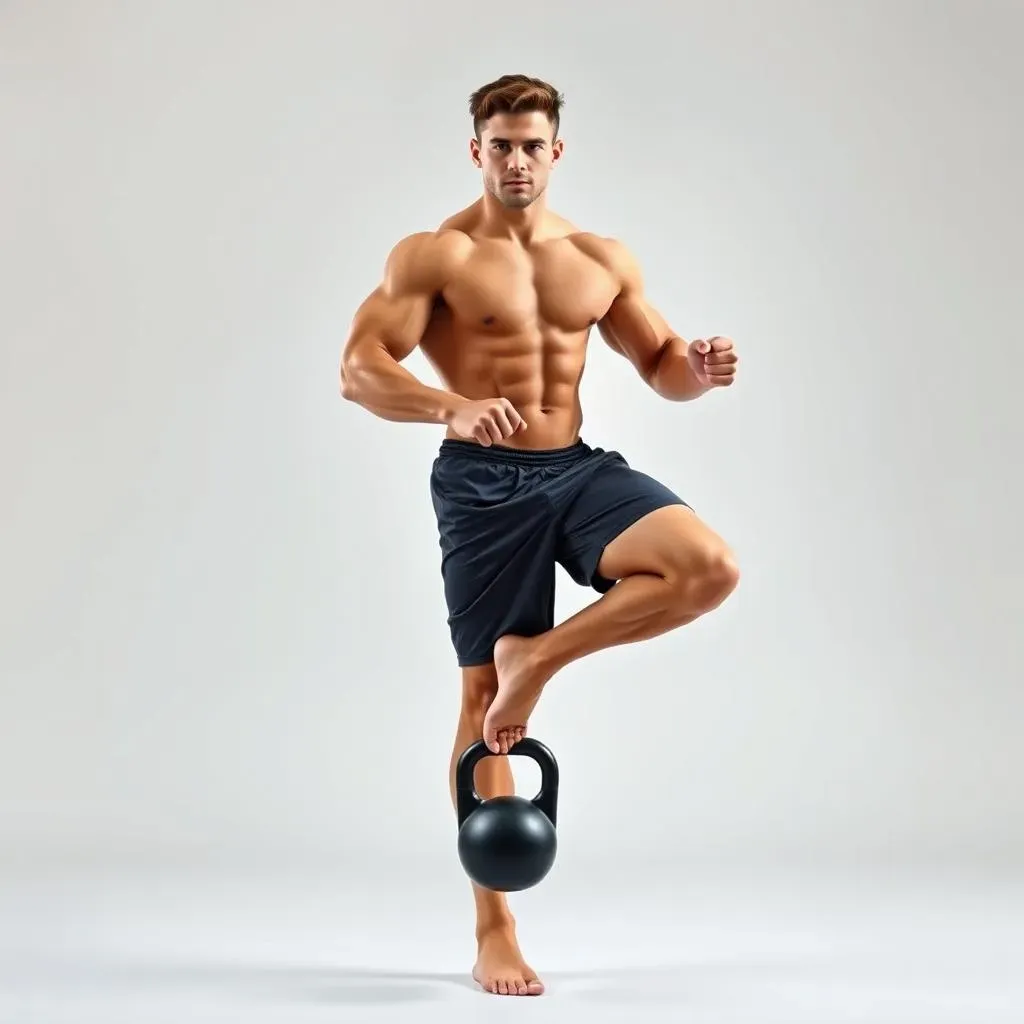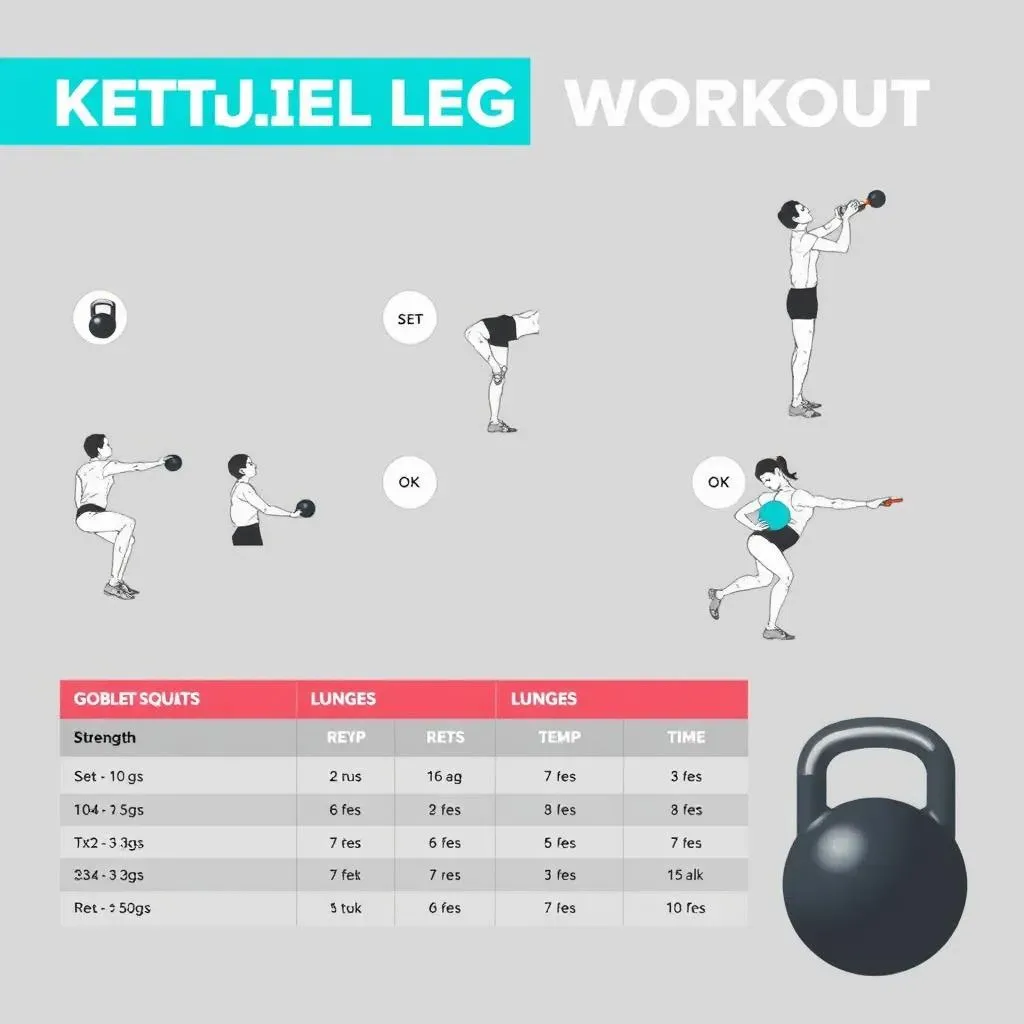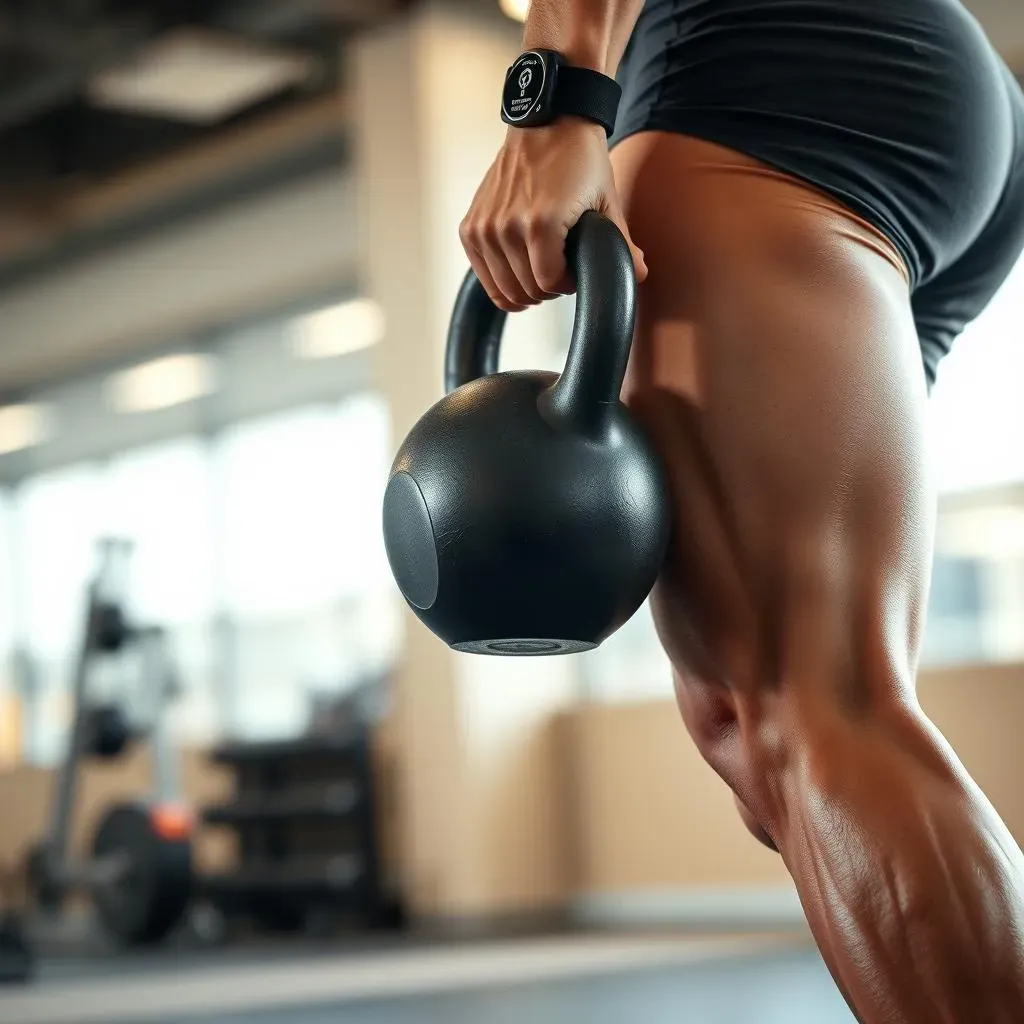Table of Contents
Tired of the same old leg day routine? Ready to shake things up and build serious strength? Then it's time to grab a single kettlebell and get to work! This isn't just about lifting weights; it's about mastering functional movement, building incredible lower body power, and sculpting legs that can handle anything life throws at them. We're diving into the world of the "single kettlebell leg workout," and trust me, it’s a game changer. Forget complicated machines and endless sets of dumbbells. With just one kettlebell, you can unlock a full spectrum of exercises that challenge your balance, coordination, and raw strength. In this guide, we’ll explore the reasons why a single kettlebell approach is so effective, the essential exercises you need to know, how to build your own killer routine, and tips for getting the best results. We will focus on key exercises like squats, lunges, and deadlifts, and also explore a few more advanced movements. Get ready to feel the burn, build some serious muscle, and revolutionize your leg workouts!
Why Choose a Single Kettlebell Leg Workout?

Why Choose a Single Kettlebell Leg Workout?
Okay, so you might be thinking, "Why a single kettlebell? Why not two? Or a barbell? Or a fancy leg press machine?" I get it. But hear me out. There's something magical about working with just one kettlebell, especially when it comes to legs. First off, it forces your body to work harder to stabilize. Think about it: holding a weight on one side immediately challenges your core and your balance. That's a win-win, because you're not just building leg muscles, you're also strengthening your midsection and improving your overall stability. This is something that will translate into all of your daily activities, not just in your workouts. Plus, a single kettlebell is super versatile. You can swing it, squat with it, lunge with it, deadlift with it – the list goes on! It's like having a whole gym in one compact, cast-iron package.
And let’s be real, who hasn't experienced the struggle of trying to balance two dumbbells during a split squat? It's like trying to juggle chainsaws. With one kettlebell, it’s much easier to focus on the movement and form. This is particularly helpful if you're new to strength training, or if you are trying to focus on correcting imbalances between your left and right side. The unilateral nature of single kettlebell training – meaning you’re working one side of the body at a time – helps expose these imbalances. It also helps you improve them over time. So, if one leg is a bit stronger or more flexible than the other, you’ll quickly find out, and your workouts will help you correct that. This leads to a more balanced and injury-resistant body.
Benefit | Why it Matters |
|---|---|
Improved Stability | Engages core and balance muscles. |
Versatility | One tool for a wide range of exercises. |
Easier to Focus on Form | Reduces the complexity of movement. |
Corrects Imbalances | Strengthens weaker side of body. |
Essential Single Kettlebell Exercises for Legs

Essential Single Kettlebell Exercises for Legs
The Foundational Moves
Alright, let’s get into the good stuff: the exercises! When it comes to single kettlebell leg workouts, we’ve got to start with the basics. These moves are the bread and butter of any solid routine, and they’ll build a strong foundation for more advanced stuff later on. First up, we have the single-leg deadlift. It’s not just about picking up a weight; it’s about control, stability, and hamstring power. Picture yourself hinging at the hips, keeping your back straight and lowering the kettlebell towards the floor. Then, squeeze your glutes to return to standing. It's like a dance, but with weights. Next, we have the goblet squat, where you hold the kettlebell close to your chest. This will help you maintain good posture and engage your core while working your quads and glutes. Make sure you go as low as you can while keeping good form. These two exercises alone are a great start to a solid leg day.
Lunges and Their Variations
Moving on, let's talk lunges. These are fantastic for building leg strength, balance, and coordination. You can do forward lunges, reverse lunges, and even lateral lunges, all with a single kettlebell. Try holding the kettlebell in the goblet position, or even by your side for an extra stability challenge. The Bulgarian split squat is another great exercise that deserves a mention here. It’s a bit tougher, but it is incredibly effective. You place one foot on an elevated surface behind you, then you lunge with the other leg, holding the kettlebell in a comfortable position. This will target your quads and glutes while simultaneously working on your balance. These lunge variations are great to add variety to your workout and hit your muscles from different angles.
Exercise | Target Muscles | Benefits |
|---|---|---|
Single-Leg Deadlift | Hamstrings, Glutes, Lower Back | Builds strength and balance |
Goblet Squat | Quads, Glutes, Core | Improves posture and strength |
Lunges (Forward, Reverse, Lateral) | Quads, Glutes, Hamstrings | Enhances balance and coordination |
Bulgarian Split Squat | Quads, Glutes | Improves balance and strength |
Adding Some Spice
Now, for those who want to spice things up a bit, let's bring in some swings and sumo deadlifts. The kettlebell swing is a full-body movement, but it really hits the glutes and hamstrings hard. It’s also a great way to get your heart rate up. Remember, it’s not a squat; it's a hip hinge. You generate power from your hips, not your arms. Then, we have the sumo deadlift, where you stand with a wider stance and the kettlebell between your legs. This variation will target your inner thighs and glutes differently than traditional deadlifts. These exercises will add some power and dynamic movement to your leg workout, helping you build strength and endurance at the same time. Don't be afraid to mix and match these exercises to make your routine fun and challenging!
Building Your Single Kettlebell Leg Workout Routine

Building Your Single Kettlebell Leg Workout Routine
Putting It All Together
Okay, so you've got the exercises down, now how do you actually put them together into a routine? Well, the beauty of a single kettlebell leg workout is that you can keep it simple and still see great results. First, think about your goals. Are you trying to build strength? Or are you focusing more on endurance? Depending on your answer, you'll adjust the number of sets, reps, and rest times. If you're new to this, start with 2-3 sets of 8-12 reps for each exercise. Focus on maintaining good form over lifting heavy, and don’t rush it. Rest for about 60-90 seconds between sets, or as needed. As you get stronger, you can gradually increase the weight, reps, or sets. Remember, consistency is more important than intensity when you are starting out.
Don’t feel like you have to do every single exercise every time you work out. You can pick 4-5 exercises and create a workout that suits your needs and goals. For example, you could do a workout that is focused on single-leg deadlifts, lunges, and goblet squats for one session, and another day you could focus on single leg deadlifts, Bulgarian split squats, and kettlebell swings. Mix it up to keep it fun and to challenge your body in different ways. Also, don’t forget to warm up before you start, and cool down afterwards. Some light cardio and dynamic stretching will do the trick. It's like prepping your engine before a race and then letting it cool down properly after, it's important for performance and longevity!
Workout Goal | Sets | Reps | Rest |
|---|---|---|---|
Strength | 3-4 | 6-8 | 90-120 seconds |
Endurance | 2-3 | 12-15 | 60-90 seconds |
Beginner | 2-3 | 8-12 | 60-90 seconds |
Sample Workout Plans
Let’s get practical. Here are a couple of sample workout plans to get you started. The first one is for beginners, focusing on building a solid foundation with the core movements. It includes Single-Leg Deadlifts, Goblet Squats, and Forward Lunges. The second routine is more advanced, adding in more challenging exercises like Bulgarian Split Squats, Kettlebell Swings, and Sumo Deadlifts. Remember, these are just examples. Feel free to adjust them to suit your fitness level and preferences. You can also add variations, like holding the kettlebell in different positions or changing the tempo of the exercises. The key is to find what works for you and to make your workouts enjoyable.
And most importantly, listen to your body. If you are feeling pain, stop the exercise, rest, and adjust your form or weight. If you're feeling good, keep pushing yourself, but always within your limits. The goal here is to build a sustainable workout routine that you enjoy and that you can keep up with for a long time. Consistency and proper form are your best friends in this journey. Remember that progress is not linear, so don’t get discouraged if you have some bad days or weeks. Just keep at it and you’ll get stronger and more confident over time.
- Beginner Routine: Single-Leg Deadlifts, Goblet Squats, Forward Lunges
- Advanced Routine: Single-Leg Deadlifts, Bulgarian Split Squats, Kettlebell Swings, Sumo Deadlifts
- Warm-up before each workout and cool down after.
- Adjust the exercises and weights as needed.
Tips for Maximizing Your Single Kettlebell Leg Workout Results

Tips for Maximizing Your Single Kettlebell Leg Workout Results
Alright, so you've got the exercises, you've got a routine, now let's talk about how to really make those single kettlebell leg workouts count. It's not just about going through the motions, it's about being smart with your training. First off, focus on progressive overload. What does that mean? It's simple: gradually increase the challenge over time. That could mean lifting a heavier kettlebell, doing more reps, adding an extra set, or even shortening your rest periods. The key is to keep pushing your body to adapt and grow. Don't get stuck doing the same thing over and over again. Your body is smart, and it will adapt to the current level of stress, so you have to keep it guessing.
Another thing to keep in mind is the importance of proper form. I know I've said it before, but it's worth repeating. It's better to do fewer reps with good form than a bunch of sloppy reps with bad form. Bad form is a recipe for injuries, and nobody wants that. So, really focus on engaging the right muscles, maintaining a straight back, and controlling the movement. If you're not sure about your form, it's a good idea to record yourself or ask a friend who is knowledgeable about exercise. Also, make sure you are getting enough rest and recovery. Your muscles need time to repair and rebuild after a workout. So, get enough sleep, eat well, and don't overdo it. Listen to your body and don't be afraid to take a rest day when you need it.
Tip | Why it Works |
|---|---|
Progressive Overload | Continues to challenge the muscles for growth. |
Proper Form | Prevents injuries and maximizes muscle engagement. |
Rest and Recovery | Allows the body to repair and rebuild. |
Let’s not forget about the mind-muscle connection. When you are doing each rep, really focus on the muscles you are trying to work. Instead of just going through the motions, try to feel your glutes, quads, and hamstrings working with each movement. This focus will help you get more out of each exercise and make your workouts more effective. Also, don’t be afraid to experiment with different variations of the exercises to keep things interesting and challenge your muscles in different ways. For example, you can try different kettlebell positions, or change the tempo of your movements. The most important thing is to find what works for you and to make your workouts fun and engaging. After all, if you enjoy your workouts, you are more likely to stick with them. So, keep it varied, keep it challenging, and keep it fun, and you will be sure to see great results from your single kettlebell leg workouts!
Finally, remember that consistency is key. It's not about having one amazing workout and then slacking off for the rest of the week. It's about showing up regularly and putting in the work, even when you don't feel like it. Try to make your workouts a habit, like brushing your teeth or having your morning coffee. The more consistent you are, the better results you will see. And don't be afraid to track your progress. Keep a workout log, take pictures, or measure your body. This will help you see how far you've come and keep you motivated. Remember, progress takes time, so be patient and trust the process. With a single kettlebell and a little dedication, you can build some seriously strong legs!
"The only way to do great work is to love what you do." - Steve Jobs
Wrapping Up Your Single Kettlebell Leg Workout Journey
So, there you have it, a complete guide to crafting powerful legs with just a single kettlebell. Remember, consistency is key. Don't expect to become a kettlebell master overnight. Start slow, focus on your form, and gradually increase the intensity as you get stronger. The beauty of single kettlebell training is its simplicity and effectiveness. You don't need a fancy gym or a ton of equipment to achieve incredible results. Whether you're a seasoned athlete or just starting your fitness journey, incorporating these single kettlebell leg exercises into your routine will transform your lower body strength, improve your balance, and leave you feeling unstoppable. Now go grab that kettlebell and get to work – your legs will thank you for it!